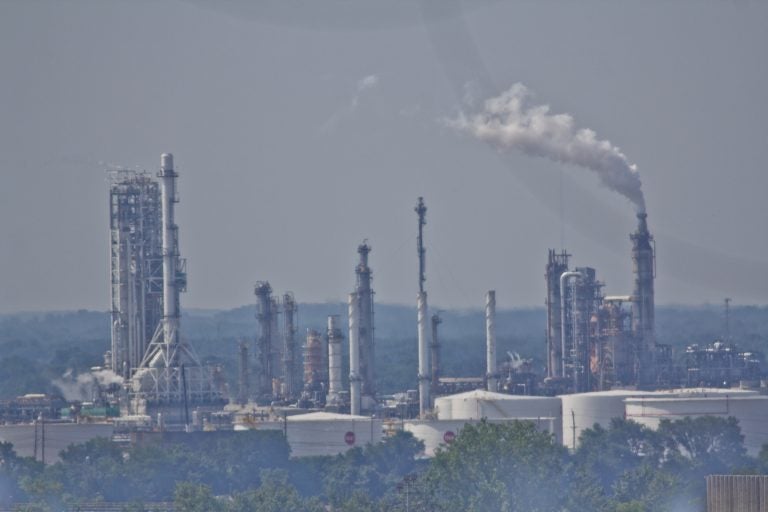PGW plan for liquified natural gas facility in Southwest Philadelphia clears hurdle
The new facility, Passyunk Energy Center LLC, would be a public-private partnership between city-owned PGW and Liberty Energy Trust, based in Conshohocken.
Listen 1:06
A Philadelphia refinery (Kimberly Paynter/WHYY)
Members of the Philadelphia Gas Commission have voted 4-1 to proceed with a $60 million plan to build a new liquified natural gas facility in Southwest Philadelphia.
The new facility, called Passyunk Energy Center LLC, would be a public-private partnership between city-owned Philadelphia Gas Works and Liberty Energy Trust, based in Conshohocken. PGW would approve all design plans and run operations upon completion, but Liberty Energy Trust would finance the construction.
City Councilman Derek Green, chairman of the commission, voted in favor and said the plan would prevent raising customers’ rates at a time when the utility is making less money because appliances are more efficient.
“We have to find a way, how do we bridge where we are currently at Philadelphia Gas Works to some future opportunities,” he said. “Using dollars that’s non-ratepayer dollars like LNG to help us do things like solar or landfill energy or other alternate ideas.”
The proposal now moves to City Council for consideration. It’s expected to take up the matter early next year.
The plant would be capable of producing 120,000 gallons of LNG a day. Right now, PGW liquefies natural gas at its Port Richmond plant and transports it to Passyunk for storage. The new plant would allow for everything to be done at the Passyunk plant, eliminating the need for transporting the LNG.
PGW spokesman Barry O’Sullivan said the project will allow the utility to move into the future without burdening its customers.
“This is the single largest bottom line revenue opportunity that we have had in the last 20-plus years,” he said. “It’s the equivalent of adding 10 percent to our bottom line annual revenue every year for the next 25 years.”
The plan is projected to bring in anywhere from $1.35 million to $4 million in revenue for PGW each year.
But environmentalists decried expanding reliance on fossil fuels, at a time when climate change has become an increasing concern. They said the plan was at odds with Philadelphia’s plan to reduce its emissions by 80 percent by 2050.
“PGW’s proposal to build an LNG plant would support our continued reliance on natural gas for much longer than scientists with the Intergovernmental Panel on Climate Change say is possible if we want to avoid catastrophic climate change,” said Matt Walker, community outreach director with the Clean Air Council.
Supporters of the project contend that the emissions effects from the project itself will be minimal and will move the city toward lowering its carbon emissions.
“The ability to move from that oil or from that coal to LNG cuts the carbon impact in half,” said PWG’s O’Sullivan.
But Christina Simeone, director of policy and external affairs at the Kleinman Center for Energy Policy at the University of Pennsylvania, said the environmental impacts depend on the customer.
“The environmental benefit will happen if LNG displaces diesel or fuel oil,” she said. “But it’s just not clear until there’s a client base who is going to be the end user of this gas.”
Simeone said PGW is being responsible in pursuing this opportunity for its customers. But questions remain about liability and risk. What happens if Liberty defaults? Will PGW and ratepayers be protected?
“There’s a lot of detail to be filled in,” she said.
City Controller Rebecca Rhynhart was the sole “no” vote. She said she was open to the idea of a future LNG project but had concerns about Liberty Energy Trust.
“There was only one bidder, which is always a concern to the city,” she said. “And the company, Liberty Energy Trust, from the information provided, has only five employees and is a small company that hasn’t had the experience with marketing this much LNG.”
But Liberty Energy Trust partner Matthew Taylor disagreed.
“We’ve done a number of LNG projects, in Boston and elsewhere in the U.S.,” he said. “We have the experience of building, designing, and financing these projects, so we think it will be a good opportunity for us and a great opportunity for PGW to benefit from that investment.”
Simeone said it makes sense to use LNG as a bridge, as Green put it, but questions remain about how long that might last, and whether LNG will still be a desirable energy source at the endpoint.
“Is it a bridge that’s going to span 10 years? Or 50 years?” she said. “Nobody has that crystal ball.”
WHYY is your source for fact-based, in-depth journalism and information. As a nonprofit organization, we rely on financial support from readers like you. Please give today.





